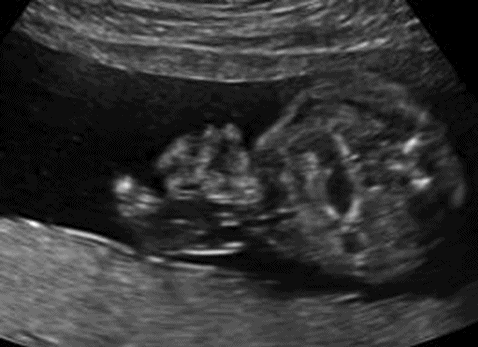Exomphalos with stomach within peritoneal sac.
The incidence is 1 in 4,000 births. There is a high association with chromosomal abnormalities (approximately 33–61% depending on gestational age) mainly trisomy 18 (the most common) and trisomy 13; 30–50% will have some form of cardiac abnormality. Paradoxically, the larger the lesion the less likely there is to be a chromosomal abnormality(1–3).
Diagnosis
The diagnosis is usually made after 12 weeks and is often detected at the first trimester dating scan in places where nuchal translucency (NT)-based screening is in place. It is best observed in the sagittal and axial views. The umbilical cord will insert onto the anterior part of the peritoneal sac and blood flow can be seen passing around the sac. In places where the triple or quadruple blood test is offered for screening, a raised alpha-fetoprotein (AFP) should prompt a search for an anterior abdominal wall abnormality.
The sac may contain bowel, stomach and liver. The bladder and stomach are often “pulled” towards the sac. In large lesions, the heart may also be shifted towards the defect. As the abdominal anatomy is distorted it is often difficult to obtain a true abdominal circumference, which may lead to inaccuracies in estimation of fetal weight or the misdiagnosis of fetal growth restriction.
Common chromosomal abnormalities associated with exomphalos are trisomy 18 and trisomy 21. Other syndromes associated with an exomphalos are Beckwith–Weidemann syndrome (macrosomia and macroglossia with renal cysts), OEIS (omphalocoele, bladder exstrophy, imperforate anus and spinal defects) and pentalogy of Cantrell (exomphalos, congenital diaphragmatic hernia, ectopia cordis, sternal cleft and intracardiac defect, usually a ventricular septal defect). A repeat anatomic survey should focus on these areas as well as the heart and features of trisomy 18 and 13. Cloacal and bladder extrophy can be associated with an exomphalos, and identification of the bladder is mandatory to exclude these conditions. Both are thought to be due to a defect in the development of the cloacal membrane.
Management
Karyotyping should be offered due to the high rate of chromosomal abnormalities, particularly trisomy 18. A full fetal echocardiogram should also be performed as approximately 30–50% will have some form of cardiac abnormality. Associated structural and/or chromosomal abnormalities worsen the prognosis. Counseling regarding the prognosis should be done in association with neonatalogists and pediatric surgeons.
The fetus should be monitored every 4 weeks with growth scans, but the true abdominal circumference may be difficult to measure, and so fetal growth restriction may be difficult to diagnose.
Delivery is best organized in a tertiary center with neonatal surgical facilities. A vaginal delivery is safe and cesarean section is not essential; cesarean section may be considered in certain cases where the exomphalos is very large. In general, the outcome is good with an 80–90% survival rate if there are no associated chromosomal or structural issues, but this depends upon the size of the lesion.
Neonatal management
A neonatal pediatrician should be present at the delivery of the baby. Initial management is focused on stabilization of the baby and the avoidance of trauma to the sac. The sac should have a moist covering to prevent evaporative heat and water loss. Neonatal management is directed at fluid balance and blood sugar monitoring.
Repair depends upon firstly the exclusion of other structural abnormalities that may not have been detected antenatally, and the size of the peritoneal sac.
If the sac is small enough, then primary repair can be performed with excision of the sac and closure of the fascia and the abdominal wall. If the exomphalos is large, then a silastic pouch may be used to reduce the viscera into the abdominal cavity and closure performed when the sac is smaller.
Gastroschisis
Gastroschisis can be defined as herniation of the abdominal wall contents medial to the umbilical cord with no surrounding membrane. It occurs in approximately 1 in 4,000 births. The exact cause of gastroschisis is unknown but is believed to be caused by a disruption of the blood supply to the developing abdominal wall from the omphalomesenteric duct artery by the 8th week of gestation. There are no known genetic associations, and so karyotyping is not indicated[1–3].

Gastroschisis in axial view with dilated internal bowel.
Diagnosis
Gastroschisis can be diagnosed at the 11–14 week scan, and as there is an open defect the AFP levels are commonly raised. However, serum screening tests including AFP are not offered in most places, so the opportunity to find a raised AFP may not arise. The exposure of the bowel to the amniotic fluid leads to thickening of the bowel wall. As in exomphalos, the bladder and heart can be pulled towards the lesion distorting the internal anatomy.
The main issue is that of bowel atresias and necrosis that need to be resected after delivery, which if severe can lead to “short bowel” syndrome where long-term parenteral nutrition is required. Unfortunately, there do not seem to be any strong prognostic indicators. Bowel thickness (>2mm), hyperperistalsis, mesenteric arterial blood flow and bowel dilatation have all been evaluated. but none seem to be particularly good at predicting the need for surgery or the length of bowel that requires resection[4]. A recent review suggested that the only predictive factor was internal bowel dilatation greater than 14mm[5].
However, a ruptured exomphalos is a possibility, so a careful secondary survey is always necessary, in particular looking for a free-floating membrane in the amniotic fluid. There are other conditions that may appear to be a gastroschisis. Limb-body wall complex or body stalk anomaly, a large anterior thoracoabdominal wall abnormality with an associated myelomeningocoele. The contents of the abdomen, pelvis and chest lie outside the body cavities and can be attached to the uterine wall or placenta. This condition is lethal. Amniotic band syndrome, due to early amnion rupture, may cause disruption of the anterior abdominal wall and a gastroschisis.





